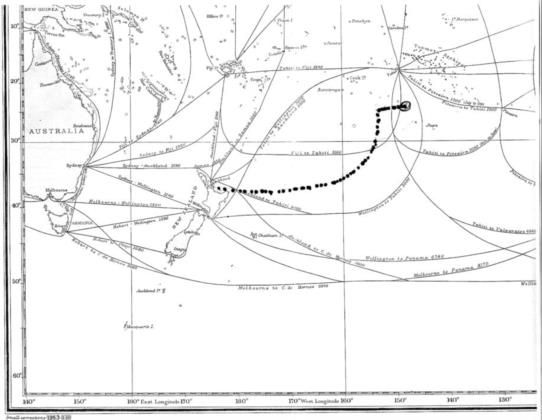
NavList:
A Community Devoted to the Preservation and Practice of Celestial Navigation and Other Methods of Traditional Wayfinding
Re: Polynesian canoes set off from New Zealand to Raiatea (French Polynesia)
From: George Huxtable
Date: 2010 May 9, 13:16 +0100
From: George Huxtable
Date: 2010 May 9, 13:16 +0100
I wonder if anyone has been following the journey of the four vakas (Polynesian voyaging canoes), which set off on an island voyage from Auckland with the intention of ending up in Rarotonga. The voyage can be followed via twice-daily reports from the vessels, on their website at- http://www.voyaging.co.ck/ . They have now arrived, more or less on schedule, at their first stop, the tiny speck of Raivavae, way South of Tahiti. The reports are rather worth reading, though without a lot of technical content, and showing a certain concentration on matters of food. Daily positions of the four vakas can be followed by a Google Earth link. At Raivavae, they were joined by a 5th canoe, which arrived fron Tahiti after being freighted there from her builders in Auckland. I have attached a map, based on a corner of Admiralty map 5309, "World - tracks followed by sailing an auxiliary powered vessels", which was supplied with "Ocean Passages for the World" of 1973, the last year in which sailing vessels were catered for. The vaka tracks are roughly shown by my dotted line, ending at Raivavae. =================== However, those reports provide a few facts about the voyage which did not appear in the initial press releases, which allow a bit of closer scrutiny, in the light of the stated aim "to revitalise the traditional art of sailing, navigation and canoe-building ". Vessels. As noted previously, these have been built as two fibreglass hulls, connected by wooden beams, and built in a New Zealand yard. Although the hulls might be a similar shape to those of the traditional wooden vaka, construction will be very different. Berth accommodation is by bunks within the two narrow hulls, which (as I understand it, but am no expert on such vessels) differs greatly in that respect from the traditional vessels, in which life is generally lived under minimal shelter on the platform itself. This showed up in the more southern part of the passage, in which the crew appeared to be confined below, within the hulls, except when actually on watch, and greeted the decision to turn northward into warmer weather with great relief. Perhaps the on-deck life in the traditional vaka was suited only to more tropical conditions. Rig. I haven't seen a detailed sail plan, but the rig appears to be traditional Bermudan in every respect, not at all the "crab-claw" rig of the traditional Polynesian craft. However, it seems that components of that rig are kept on board, because on the last day at sea before arrival at Raivavae, a crab-claw arrangement was hoisted, to give a better impression on entering harbour. That attitude, of deliberate cosmetic deceit, rather saddens me. If tricks like that are considered acceptable, can we take anything at face-value? Anyway, there's some doubt in my mind about whether a crab-claw rig would be compatible at sea with the way a Bermudan mast is stayed. Navigation. It was stated that one of the vessels would be navigated without instruments, but instead rely on the collective wisdom of the elders on board. The others appear to be fully instrumented, with GPS. As they were all sailing in close company, within visual range and radio contact, I doubt whether that collective wisdom played a major part. Warnings of approaching weather were being received, presumably by satellite comminication via the support-vessels (of which more anon). The group initially took a proper track, somewhat South of East, in accordance with sailing-ship advice for passage to Tahiti (Raivavae is close to that track), to keep within the Westerlies. But that recommended track shows ships approaching the Raivavae area from the South. Instead, the vakas soon headed more Northerly, and then took a due-North tack; somewhat prematurely in my view, because it would then put them West, and downwind, of their destination. And so it turned out to be. As a result, the two support vessels were then called on to tow the vakas, in strings of two, for the rest of the leg to the island. These were two big charter yachts, fully equipped, "Foftein" and "Evohe". They were not mentioned in the press releases at the start of the voyage. Next leg. The next leg of the journey is to be to Papeete, Tahiti, which is a Northerly passage, across the wind. Presumably, the group will expect to approach from the East, with the prevailing wind. To get into that position will provide a good test of the windward ability of the vessels. It will be interesting to see if they can make it without further towing. You can judge for yourself, then, whether the initial aim "to revitalise the traditional art of sailing, navigation and canoe-building" has been met by this voyage. In my view the answer is "not at all". In every respect, it has been reliant on Western technology. That's a pity, but no amount of spin in the press-releases can really hide the fact. It will be interesting to read future press-releases to see what emerges. And it will be interesting to follow the progress of the voyagers in their journey. I wish them well, and hope they enjoy it. George. contact George Huxtable, at george@hux.me.uk or at +44 1865 820222 (from UK, 01865 820222) or at 1 Sandy Lane, Southmoor, Abingdon, Oxon OX13 5HX, UK.







